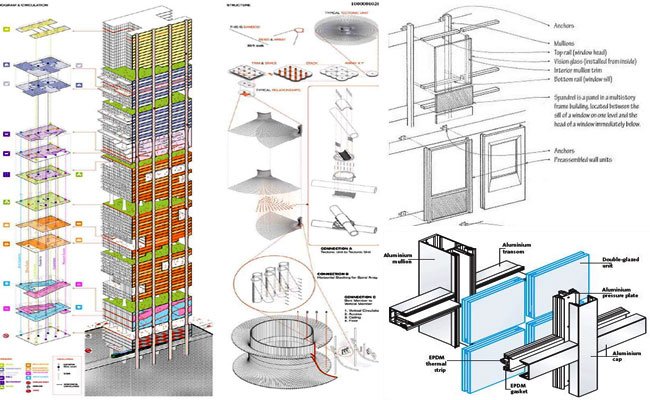Types and benefits of a curtain wall

A curtain wall belongs to a skinny and lightweight system generally made of aluminum and glass. These walls are not structural, and by design, they can only bear their self weight, whereas transmitting the load of wind and gravity to the structure of the building.
The curtain wall contains a full cladding and external wall system exclusive of the indoor finishes.
It is normally fabricated from aluminium frames, vision glass and spandrel glass (metal or stone) panels to encircle a building from grade to the roof.
The curtain wall system is categorized as three types like stick built system, the unitized (or panel) system and the structural glazing system (capless vertical joints).
There are different components in a curtain wall like anchors, mullion, horizontal rail, spandrel panel, vision glass. The objective of the mullions is to transmit the dead load of the curtain wall. Mullion joints should be set at the bracket position and aluminium stiffeners should be arranged for bringing additional stability.
Variations among stick systems and unitized systems:-
Stick systems
- The curtain wall is set up piece by piece at the construction site.
- Thermal enlargement and contraction of mullions are adjusted with expansion joints in mullions.
- The components of this system are fabricated in shop and transported.
- This system has low transportation costs and it allows superior quality of on-site modification with reference to the other systems.
Unitized system
- This system comprises of framed wall units which are shop fabricated, preassembled and normally pre glazed.
- The design of the units is created in such a manner that the vertical and horizontal members in adjoining units are interconnected to develop common mullions and rails.
- Its superior degree of quality control is produced from shop fabrication.
Benefits of curtain walls
- Due to the application of lightweight materials, curtain wall systems are considered as an reasonable option for a building’s external casing.
- The curtain walls are energy efficient since they have the capacity to withstand air and water permeation. It will minimize your cost of heating, cooling, and lighting the building.
- Based on the needs and preference for the project, the curtain wall system can be set up in small or large units. The walls may extent from the floor to ceiling or set up over several floors to bring superior flexibility in design.
- The system also adapts building drift and seismic movements.

